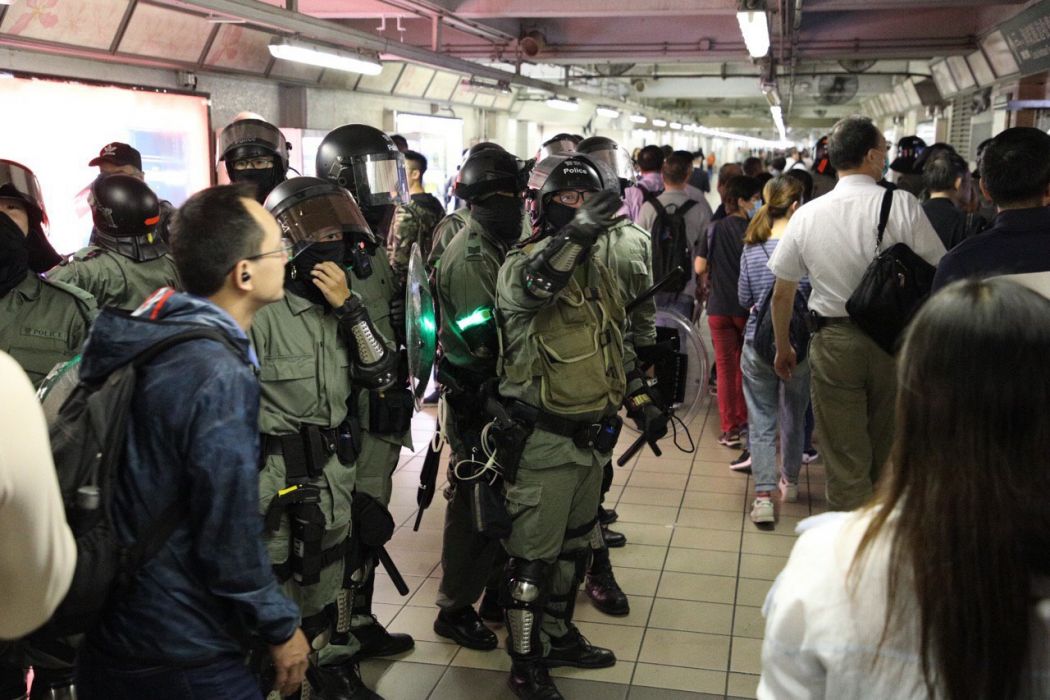By Holmes Chan, Kris Cheng and Jennifer Creery
Hong Kong police have fired multiple live rounds and volleys of tear gas as protesters disrupted the morning commute on Monday in keeping with a larger plan to mobilise a general strike.
Some organisers said on Telegram they would gather at 6:30am, and start paralysing the MTR and surface traffic from 7am onwards. The protest – nicknamed “Dawn Action” – was described by its proponents as a way to dial up the pressure on the government.

At around 7:00am, the MTR announced the closure of Tung Chung Station due to an “escalation” of events, followed by Whampoa station at 8:18am, and Kwai Fong Station at 8:53am. Services were disrupted on the Kwun Tong Line, Tung Chung Line, East Rail Line, and the Ma On Shan Line. Light rail services have also been affected by the strike action.
Makeshift roadblocks were erected in multiple areas of the city, including one inside of the Chinese University of Hong Kong in Sha Tin, as well as other parts of Yuen Long, Hung Hom, Tsuen Wan and Wong Tai Sin. Arrests were made in Tuen Mun, Wong Tai Sin and Sha Tin, according to local media.

In Sai Wan Ho, protesters blocked the intersection outside Tai On Building. At around 7:15am, a police officer tried to chase after them before he pulled out a service pistol and pointed it at them, according to footage captured by Cupid Producer. He grabbed a protester in white, and shot another black-clad protester in the stomach at close range.
The transport disruptions coincided with calls for a citywide strike, which urged students to boycott classes, business owners to close shops, and employees to skip work.

Protesters had vowed to escalate their tactics after the death of 22-year-old Alex Chow Tsz-lok, who succumbed to his injuries after falling one storey in a car park. While the cause of Chow’s death remains unclear, riot police had been conducting dispersal operations of a protest nearby at the time of his fall.
Campus tear gas
In Hung Hom, police entered the campus of Polytechnic University to round-up protesters. While arguing with people inside, one riot police officer said: “I can arrest whomever I like,” according to In-Media. Police then fired tear gas inside the campus shortly after 7:40am.
At 7:43am, riot police officers fired tear gas inside Polytechnic University, the first time they have used tear gas inside a university campus. #HongKongProtests
Source: @cityusucbc https://t.co/GzAy5dhxf8 pic.twitter.com/Olcy9m8NWN
— stay at home (@hyjpang) November 11, 2019
On Monday, the Hong Kong Baptist University, the Hong Kong Shue Yan University, the Open University of Hong Kong, the Hong Kong University of Science and Technology (HKUST), and the Chinese University of Hong Kong – where police had also fired tear gas – announced all classes would be cancelled. Hong Kong Polytechnic University said all classes before 2:30pm would be cancelled.
In footage widely shared online, a police motorcyclist in Kwai Fong appeared to drive into a crowd of black-clad protesters three times before taking off.

The government released a statement shortly after 8:40am condemning the traffic disruptions: “Police warn the protestors to stop their illegal acts immediately. Police [are] now clearing the barricades that caused serious obstruction to traffic. We appeal to commuters to reserve time, and stay tuned to the latest traffic announcements,” it read.
Shortly after 10am, the Chu Hai College and the Vocational Training Council suspended all classes.
At around 10:22am, police fired tear gas in Sai Wan Ho whilst an angry crowd heckled officers and protesters scattered bricks on the road.

The HKUST – where Chow was a former student – said the cancellation of its classes on Monday was to make time for repairs.
According to the school, its campus “experienced mass-scale malicious vandalism” on Friday and resulted in many sites being “damaged and heavily spray-painted.” Students and protesters gathered at HKUST for a vigil, while some defaced the residence of university head Wei Shyy.
“HKUST is deeply saddened to see that the ongoing turmoil in Hong Kong has spread to universities. The incident has caused many HKUST staff and students to start worrying about their personal safety,” the university said in a statement.
“The Government must propose feasible solutions to the current social disputes so that peace and order can be restored in the entire society. The University once again calls on all parties to remain calm and restrained. Violence cannot solve any problems and will only intensify conflicts and inflict greater damage.”

While the idea of a general strike gained traction on Telegram and the Reddit-like forum LIHKG, its detractors said that Hong Kong was not ready for mass-scale labour action since strikers do not have unions to back them up.
Strikers would remain a minority without unionisation and long-term support, meaning that they will face retaliation from their employers once the strike ends, the critics added.
On August 5, protesters also called for a general strike, which came with multiple community-level rallies for strikers to attend in the afternoon. Thousands were estimated to have joined the strike, though police declared the rallies unlawful and fired tear gas to disperse participants.
More to follow.
Hong Kong Free Press relies on direct reader support. Help safeguard independent journalism and press freedom as we invest more in freelancers, overtime, safety gear & insurance during this summer’s protests. 10 ways to support us.

